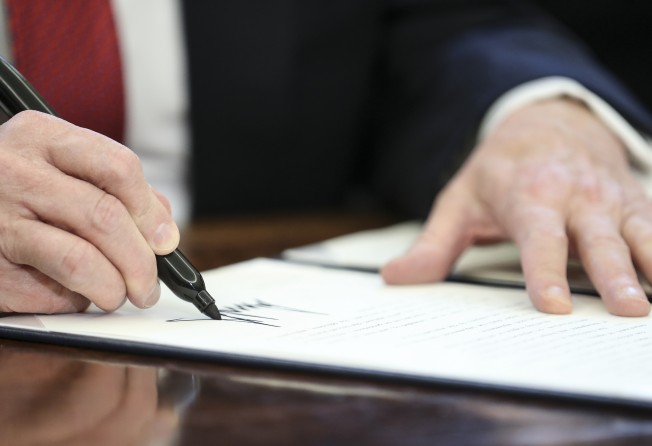Is Trump’s AI executive order a Sputnik moment for the US?
- Competition between the US and China in AI is shaping up to be like a new ‘space race’

US President Donald Trump’s executive order on artificial intelligence may be short on details, but its broader significance lies in his administration’s recognition that China has become a strategic competitor in a critical technology, industry watchers say.
The executive order, which Trump described as his “American AI initiative”, was signed on Monday and directs federal agencies to prioritise investments in research and development of AI.
While it did not specifically mention China, the executive order “has emerged under the context” of increased competition with China, said Gregory Allen, an adjunct senior fellow at the Washington-based Centre for a New American Security. The realisation that China has become an important player in AI is only a “more recent phenomenon”, he said.
The executive order, which provided few details on how it is to be implemented and did not earmark any specific funding, said investment in AI is vital to create “technological breakthroughs in AI and related technologies” that would contribute to US economic and national security.
“This is a tacit acknowledgement that China is advancing quickly in AI,” said Paul Haswell, a partner who advises technology companies at international law firm Pinsent Masons. “Much of this US initiative looks like window dressing, and a reactionary step to counter reports that China is rapidly advancing in its AI capabilities.”
The executive order also shows that competition between the US and China in AI is shaping up to be like a new “space race”, according to Liu Guohong, a director at Shenzhen-based think tank China Development Institute.
In 1957, the US was caught unprepared when the Soviet Union launched the world’s first Earth-orbiting satellite called Sputnik 1. The event galvanised the US into action, igniting a space race that eventually led to the country’s successful landing of the first human on the moon in 1969.
Liu said a strong government directive in the US could help mobilise its industries to double down on AI research and development to rival China’s investments.
Trump’s executive order on AI has come several months after he received a memo in May from then-Defence Secretary James Mattis, who reportedly suggested the creation of a national strategy for AI to keep pace with China.
The AI initiative reflects the sense of urgency by White House officials on the need to redouble the country’s efforts to stave off the technological challenge from China.
The world’s second-largest economy has not been shy about its ambitions for AI dominance. The country’s State Council released a road map in July 2017, with the goal of creating a domestic industry worth 1 trillion yuan (US$147 billion) and becoming a global AI powerhouse by 2030.
This [executive order] is a tacit acknowledgement that China is advancing quickly in AI
After many false starts in the 20th century, AI is finally making waves and capturing the attention of policymakers around the world because of concurrent advances in computing power, data collection and theoretical understanding.
The practical applications of AI are huge – from diagnosing serious illnesses like lung cancer using medical imaging, to improving manufacturing processes using sensors and big data, to enhancing security and surveillance at immigration controls at airports using facial recognition technology. AI also has military uses.
Although the US had a head start, AI has assumed a key role in Beijing’s “Made in China 2025” (MIC2025) master plan, which seeks to lift the country’s industries – from robotics and aerospace to new materials and new energy vehicles – up the value chain, replacing imports with local products and building global champions able to take on Western giants in cutting-edge technologies.
China’s AI development is now embroiled in the wider row over MIC2025, which has become a lightning rod in the trade war between the US and China.
“While the US has more experience in spurring innovation, China has the advantage of building a good ecosystem to foster AI applications,” said An Hui, director of the Information Industry Research Institute at CCID Wise, a think tank under the Ministry of Industry and Information Technology. He is also chief secretary at the Artificial Intelligence Innovation Alliance.
The mainland is already home to the most number of AI start-ups valued at least US$1 billion, according to CB Insights, a research firm that tracks venture capital activity. Six of the 11 so-called unicorns in the annual CB Insights compilation are from China, led by SenseTime with a valuation of US$4.5 billion.
Since 2014, China has led the world in most patent filings in AI, followed by the US, according to a study by the World Intellectual Property Organisation.
“In both AI and semiconductors, China has dramatically shrunk the gap between its domestic firms and leading international ones,” wrote Allen, from the Washington-based Centre for a New American Security, in his report “Understanding China’s AI Strategy” published this month.
Still, the US is expected to make up some lost ground based on the country’s new AI initiative. An, from the Information Industry Research Institute, said the US is likely to encourage more innovation to come out of collaborations between universities, private networks and public institutions.
Allen dismissed the notion that competition between the US and China will “necessarily” end up as a zero-sum game. “Certainly there are plenty of benefits [from AI] in areas such as manufacturing and heath care that can profit every part of the global economy, just like the adoption of electricity,” he said.